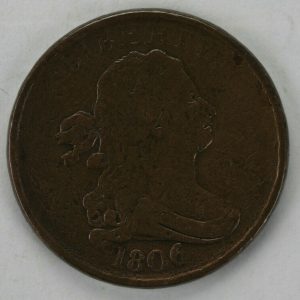Draped Bust Half Cent (1800-1808)
Half Cents (1793-1857)
The inclusion of this denomination within the Mint Act of 1792 was at the insistence of Alexander Hamilton, who reasoned that a coin of such low value would be useful to the poor. Also, the prevalence in circulation of Spanish silver coins valued at 12-1/2 cents suggested the need for half cent pieces. While the product of sound logic, the fact is that half cents were never popular, and the U. S. Mint typically made them only when cent planchets were not available. Few banks or businesses ordered these coins, and the Mint was frequently overstocked with them.
The Liberty Cap Half Cents of 1793-97 actually include several subtypes in the portrait of Liberty and the details of the wreath. Numerous varieties resulted from the use of extensive hand punching in the preparation of the dies and from the employment of different edge devices. The planchets on which these coins were struck are almost universally of poor quality, and all but a few varieties are scarce. Half cents dated 1796 are all rarities.
The Draped Bust Half Cents of 1800-08 were coined from better copper, though they too are known struck over defective large cents that were cut down to size. Most half cents of this type are weakly struck, particularly at their borders. There are no rare dates in this series. Certain varieties of 1804 and 1806 are relatively common in uncirculated condition, whether toned to brown or a combination of red and brown with black spotting.
In 1809 the Classic Head type was introduced. This design was employed as late as 1836, though with a long interruption from 1812 through 1824 when no half cents were minted. Rare dates include 1811, 1831 and 1836. The latter two are believed to have been proof-only issues, though a few 1831 half cents are known in worn condition.
The coining of half cents for circulation was suspended from 1836 through 1848. Proofs only were made of the Coronet-Braided Hair type dated 1840-48. This type remained in use through 1857, when the half cent denomination was abolished. Coins were struck for circulation with every date from 1849 through 1857, the sole exception being the proof-only issue of 1852.
Perhaps due to a glaring lack of date continuity, half cents have never enjoyed the popularity of large cents with collectors. Sought primarily by type collectors, half cents do have a modest following of date collectors, too.
Most date collectors are likewise seeking these coins by varieties. Though a number of dates, particularly during the Coronet period of 1849-57, have just a single variety per date, the earlier issues of 1793-1806 are rich in highly distinctive varieties.
Showing the single result

